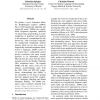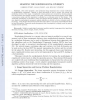264 search results - page 16 / 53 » Learning Linearly Separable Languages |
COLING
2010
13 years 3 months ago
2010
We present a novel Evaluation Metric for Morphological Analysis (EMMA) that is both linguistically appealing and empirically sound. EMMA uses a graphbased assignment algorithm, op...
ICDM
2009
IEEE
14 years 3 months ago
2009
IEEE
Abstract—Linear discriminant analysis (LDA) is a wellknown dimension reduction approach, which projects highdimensional data into a low-dimensional space with the best separation...
NAACL
2007
13 years 10 months ago
2007
We propose three new features for MT evaluation: source-sentence constrained n-gram precision, source-sentence reordering metrics, and discriminative unigram precision, as well as...
TVCG
2008
13 years 8 months ago
2008
Surveys and opinion polls are extremely popular in the media, especially in the months preceding a general election. However, the available tools for analyzing poll results often r...
SIAMIS
2010
13 years 3 months ago
2010
This article proposes a new method for image separation into a linear combination of morphological components. Sparsity in fixed dictionaries is used to extract the cartoon and osc...


